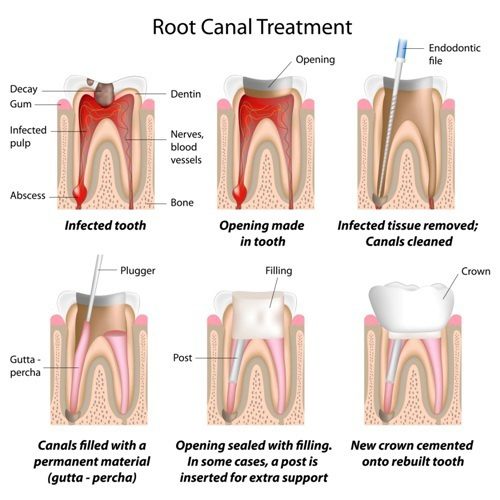
Root canal treatment is carried out when the pulp (or nerve) inside the tooth is damaged or becomes infected. If an infected pulp is not treated, it may develop into an abscess.
Bacteria can live on the dead tissue inside the tooth. They produce toxins that can leak into the bone around the tooth making the tooth painful to bite on.
The dentist will numb the tooth and may place a small rubber sheet – called a rubber dam – over the tooth to prevent anything from falling to the back of the mouth and to mask the taste of the liquids used to clean out the tooth. He/she will then remove the damaged tissue and bacteria inside the tooth and make the root canal as clean as possible. Once it is clean, it is filled with a special material so that bacteria cannot re-enter. Finally, a permanent filling is placed to seal up the tooth.
The dentist is likely to take x-rays before, during and after the treatment. This is because it is necessary to know how many roots the tooth has and what shape and length they are. X-rays after treatment are done to confirm that the root canal has been adequately filled. A tooth may have several root canals. It takes time to find them and clean them out thoroughly. So, it might take one or more visits to complete the treatment, depending on the tooth. If more than one visit is needed, the tooth will have a temporary filling placed in it until the next appointment.
If the tooth is painful, the only options for getting rid of the pain are root canal treatment or extraction. Sometimes a dead tooth causes no pain and is discovered by chance. It may be possible to leave the tooth until it causes problems.
Root canal treatment may fail due for a number of reasons. Sometimes, removing the old root filling and replacing it with a new one will solve the problem. At other times, it may be more sensible to extract the tooth.
A root-filled tooth often needs to be fitted with a crown (cap).
Once the root canal filling has been completed successfully, the tooth can remain in function for many years.
Your teeth are held in place by roots that extend into your jawbone. Front teeth usually have one root. Other teeth, such as your premolars and molars, have two or more roots. The tip of each root is called the apex. Nerves and blood vessels enter the tooth through the apex, travel through a canal inside the root, and into the pulp chamber, which is inside the crown (the part of the tooth visible in the mouth).
An apicoectomy may be needed when an infection develops or persists after root canal treatment, or retreatment. During root canal treatment, the canals are cleaned, and inflamed or infected tissue is removed. Root canals are very complex, with many small branches off the main canal. Sometimes, even after root canal treatment, infected debris can remain in these branches and possibly prevent healing or cause re-infection later.
The main purpose of an apicoectomy is to save your tooth before the infection leads to compete destruction of the tooth making it necessary to perform an extraction. To avoid this, your dentist will remove the tip (apex) of the infected root to prevent the infection from spreading further. The procedure consists in making an incision at gum level and lifting the gum to expose your tooth. Once the dentists reach the root, sometimes by using a drill, he will remove all the remaining infected tissue as well as the tip of the root. Once the area is cleaned, the dentist will seal the root.
An apicoectomy is sometimes called endodontic microsurgery because the procedure is done under an operating microscope.






























